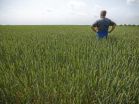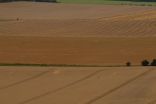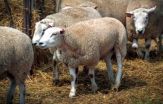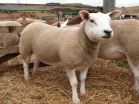(Press-News.org) Despite political proclamation of increased environmental focus, experts argue that the European Union's recent agricultural reforms are far too weak to have any positive impact on the continent's shrinking farmland biodiversity, and call on member states to take action.
About half of all farmland and at least 88% of EU farmers are exempt from Ecological Focus Areas, the main "greening measure" that could help wildlife on farmland.
Meeting EU's own biodiversity targets for 2020 now relies on initiatives from member states.
Experts from leading organisations offer six 'immediate actions' needed to be taken by member states, and six actions for the EU to avoid reforms that allow on-going agricultural intensification under a 'green' label.
Latest reforms of the EU's Common Agricultural Policy (CAP) have been declared significantly "greener" by the Members of the European Parliament, following promises to make the environment and climate change 'core issues' for the new CAP.
However, leading conservation experts writing in the journal Science warn that after three years of CAP negotiations the environmental reforms are so diluted they will be of no benefit to European wildlife, and biodiversity will continue to decline across the continent.
Under the new CAP almost a third of direct payments to farmers are now subject to conditions relating to 'greening measures'. However, disagreements over the measures have led to a wide range of exemptions being put in place.
After analysing the details of the reformed CAP, experts from a number of major organisations revealed that about half of all farmland and 80-90% of all the farmers in the EU could be exempt from having to abide by two of the three new environmental requirements. At the same time, budgets to support voluntary 'greening measures' have been reduced.
Individual member states must use the flexibility offered by the reforms to design national plans for sustaining ecosystems, say the experts. Unless member states take serious steps beyond those required for the CAP, the EU's own biodiversity targets for 2020 are very unlikely to be met.
"The weak environmental reforms in the CAP put the fate of Europe's declining biodiversity at the hands of the individual member states," said Dr Guy Pe'er, lead author from the Helmholtz Centre for Environmental Research, who collaborated with a range of experts from the Universities of Cambridge, Kent, Freiburg, Hohenheim, Bern, Wageningen MTA Centre for Ecological Research, Hungary; Writtle College, and several conservation organizations (the Society for Conservation Biology, Royal Society for Protection of Birds, BirdLife Europe, Butterfly Conservation Europe and Friends of the Earth – Switzerland).
"The EU should openly communicate this dependency, and encourage member states to make responsible decisions, rather than pretend that the reform allows meeting the EU's important ecological targets", says Pe'er.
The authors maintain that expansion of the EU and its common market continues to drive agricultural intensification across Europe at the expense of wildlife and natural habitats. .
The Common Agricultural Policy – which uses almost 40% of the EU's budget and influences the management of half of its entire territory – provides subsidies that increase the scale of farming throughout the EU. This has led to increased grassland conversion and peatland drainage. The situation is particularly severe in new member states, where the use of agri-chemicals such as fertilizers has grown rapidly.
This continues to take a heavy toll on wildlife, with dramatic declines in everything from the farmland bird index to 'permanent' grassland that, in newer member states, has shrunk over 11% in just the last decade.
To address this, the new CAP made 30% of all direct payments to farmers conditional on compliance with three 'greening measures': establishing Ecological Focus Areas, maintaining permanent grasslands, and setting minimum requirements on number of crops grown to stop areas slipping into homogenous 'monocultures'.
However, following thorough analysis, experts have found that the large number of clauses introduced to the greening measures exempt over 88% of farmers in the EU, and over 48% of its agricultural areas from having to incorporate Ecological Focus Areas. 81% of arable farmers are now exempt from the crop diversity measure, and the measure meant to protect natural grassland allows a further loss of 5% of their extent by 2020.
"The measures themselves do not include quality criteria for what counts as green," said Pe'er. "There is little evidence of safe-guards in place to prevent continuing intensification of agricultural practices".
The authors conclude that the CAP reforms fail to fulfil Target 3A of the EU Biodiversity Strategy, which explicitly requires the EU to "maximise areas […] covered by biodiversity-related measures under the CAP".
"Many regions of the new member states, and countries of southern Europe, are still supporting very high biodiversity", says András Báldi from the MTA Centre for Ecological Research, Hungary. "But there are new member states who were against agri-environment schemes, and some already decided to shift budgets away from Rural Development into Direct Payment for farmers, where the vast majority of farmers are exempt of any environmental requirements installed. Without obligation from Brussels, we may see no greening taking place".
"The EU Biodiversity target implicitly assumes that the biodiversity-related measures under the CAP are effective at protecting wildlife. While some specific, carefully designed actions – such as planting flowers for pollinators, restoring species-rich grassland, or providing nesting areas for ground-nesting birds – have been shown to work when properly implemented, these are not included as options under the new compulsory greening elements," said Dr Lynn Dicks, a co-author from the Department of Zoology in the University of Cambridge.
"The CAP should pay for 'public goods' associated with sustainable farming: thriving wildlife, beautiful landscapes, clean water, fertile soils, land that contributes to a stable climate, and diverse communities of wild insects to pollinate crops or regulate pest outbreaks. These are things enjoyed by everyone but not so easy to pay for through food sales."
"Finding a way to produce enough food for humanity without losing these assets is perhaps the biggest challenge of the twenty-first century. Unfortunately, the latest CAP reform has not found a way to secure them."
The authors offer six 'immediate actions' that states should take. These include maximising budgets to Agri-Environment Schemes, and carefully defining what crops and management prescriptions qualify as Ecological Focus Areas.
They also list six recommendations for the EU to consider towards the next, still-much-needed revision of the CAP.
They hope these recommendations encourage individual states and the EU as a whole to move towards sustainable agriculture, securing biodiversity and vital ecosystem services for current and future generations.
INFORMATION:
G. Pe'er, L. V. Dicks, P. Visconti, R. Arlettaz, A. Báldi, T. G. Benton, S. Collins, M. Dieterich, R. D. Gregory, F. Hartig, K. Henle, P. R. Hobson, D. Kleijn, R. K. Neumann, T. Robijns, J. Schmidt, A. Shwartz, W. J. Sutherland, A. Turbe, F. Wulf and A. V. Scott (2014): EU agricultural reform fails on biodiversity. SCIENCE, 6 June 2014, Vol. 344, Issue 6188. DOI: 10.1126/science.1253425.
http://dx.doi.org/10.1126/science.1253425
For an open access version of the paper and download of high-resolution pictures see http://www.ufz.de/index.php?en=1625
Further information:
The EU Biodiversity 2020 Strategy: http://ec.europa.eu/environment/nature/biodiversity/comm2006/2020.htm
The Convention on Biological Diversity Aichi Targets: http://www.cbd.int/sp/targets/
The following institutions were involved in writing this paper (authors are listed below with appropriate institution number):
1. UFZ - Helmholtz Centre for Environmental Research, Department of Conservation Biology, 04318 Leipzig, Germany.
G. Pe'er (English, Hebrew)
+49-(0)341-235-1643
http://www.ufz.de/index.php?en=15885
K. Henle (German, English)
+49-(0)341-235-1270
http://www.ufz.de/index.php?en=1868
R. K. Neumann (German, English)
http://www.ufz.de/index.php?en=21429
2. University of Cambridge, Department of Zoology, CB2 3EJ Cambridge, UK.
L. V. Dicks (English)
+44 (0)1223 761362
http://www.zoo.cam.ac.uk/directory/lynn-dicks
3. Microsoft Research - Computational Science Laboratory Cambridge, Cambridge CB12FB UK.
P. Visconti (English, Italian)
http://research.microsoft.com/en-us/people/a-pierov/
4. University of Bern, Institute of Ecology and Evolution, Department of Conservation Biology, Bern, Switzerland.
R. Arlettaz (French, English)
+41 (0) 31 631 3161
http://www.iee.unibe.ch/cb/content/about_us/staff/arlettaz/index_eng.html
5. MTA Centre for Ecological Research, Vácrátót 2163 Hungary.
A. Báldi (Hungarian, English)
http://www.nhmus.hu/~baldi/
6. University of Leeds, School of Biology, Leeds LS29JT UK.
T. G. Benton (English)
+44(0) 113 34 32886
http://www.fbs.leeds.ac.uk/staff/profile.php?tag=Benton_T
7. Butterfly Conservation Europe, Wageningen, NL.
S. Collins (English)
http://www.bc-europe.eu/
8. University of Hohenheim, Institute for Landscape and Plant Ecology, 70599 Stuttgart, Germany.
M. Dieterich (German, English)
+49 (0)711 45923530 or +49 (0)7021 735942
https://ecology.uni-hohenheim.de/person/martin-dieterich-1
9. RSPB Centre for Conservation Science, The Lodge, Sandy, Bedfordshire SG19 2DL, UK.
R. D. Gregory (English)
http://www.rspb.org.uk/ourwork/science/team/361899-richard-gregory
10. University of Freiburg, Department of Biometry and Environmental System Analysis, 79085 Freiburg, Germany.
F. Hartig (German, English)
+49-761-203-3747
https://www.biom.uni-freiburg.de/mitarbeiter/hartig
11. Eberswalde University for Sustainable Development, Centre for Econics and Ecosystem Management, 16225 Eberswalde, Germany.
P. R. Hobson (English)
+49-3334-657-178
http://www.centreforeconics.org/the-centre-and-who-we-are/who-we-are/
12. Wageningen University, Resource Ecology Group, 6708 PB Wageningen, The Netherlands.
13. Alterra, Animal Ecology Team, 6700 AA, Wageningen, The Netherlands.
D. Kleijn (Dutch, English)
+31-317-485807
https://www.wageningenur.nl/en/Persons/David-Kleijn.htm
14. Stichting BirdLife Europe, 1060 Brussels, Belgium.
T. Robijns (Dutch, English)
+32 (0)2 238 50 91
http://www.birdlife.org/europe-and-central-asia/partnership/team
15. UFZ - Helmholtz Centre for Environmental Research, Department of Environmental Politics, 04318 Leipzig, Germany.
J. Schmidt (German, English)
+49-(0)341-235-1406
http://www.ufz.de/index.php?en=31839
16. Technion Israel Institute of Technology, Faculty of Architecture and Town Planning, 32000 Haifa, Israel.
17. University of Kent, Durrell Institute Conservation and Ecology, CT2 7NZ Canterbury, UK.
A. Shwartz (English, Hebrew)
18. BIO Intelligence Service, 9200 Neuilly-sur-Seine, France.
A. Turbe (English)
http://www.biois.com/en/bio-team/project-managers/anne-turbe-2.html
19. Pro Natura - Friends of the Earth Switzerland, 4018 Basel, Switzerland.
F. Wulf (German, English)
+41(0) 61 317 92 42
http://www.pronatura.ch
20. The University of Reading, School of Agriculture, policy and development, Centre for Agri-Environmental Research (CAER), RG6 6AR Reading, UK.
A. V. Scott (English)
+44 (0)118 378 4541
http://www.reading.ac.uk/caer/staff_anna_scott.html
New EU reforms fail European wildlife
2014-06-05
ELSE PRESS RELEASES FROM THIS DATE:
What's in the sheep genome? Wool see
2014-06-05
After eight years of work, researchers have completed the first sequencing of the entire sheep genome.
Scientists from CSIRO led an international research team to complete the sequencing, which could lead to more effective breeding strategies and new approaches to the management of sheep in Australia and around the world.
With about 70m head of sheep in Australia and 1bn globally, the sequencing of the genome could have a massive impact for the rural economy given that sheep are a major source of meat, milk and wool products.
"We investigated the completed genome to ...
Sleep after learning strengthens connections between brain cells and enhances memory
2014-06-05
June 5, 2014 -- In study published today in Science, researchers at NYU Langone Medical Center show for the first time that sleep after learning encourages the growth of dendritic spines, the tiny protrusions from brain cells that connect to other brain cells and facilitate the passage of information across synapses, the junctions at which brain cells meet. Moreover, the activity of brain cells during deep sleep, or slow-wave sleep, after learning is critical for such growth.
The findings, in mice, provide important physical evidence in support of the hypothesis that ...
Scientists crack sheep genome, shining spotlight on rumen evolution and lipid metabolism
2014-06-05
Shenzhen, June 5, 2014--- The latest study, led by scientists from Kunming Institute of Zoology, Chinese Academy of Sciences, BGI and other institutes, presents a high-quality sheep genome and reveals genomic and transcriptomic events that may be associated with rumen evolution and lipid metabolism that have relevance to both diet and wool. The work was published online today in Science.
Sheep are ruminants with a complex, 4-compartmented "stomach", the largest compartment is the rumen, which is thought to have evolved around 35-40 million years ago, and has the ability ...
Gene study shows how sheep first separated from goats
2014-06-05
Scientists have cracked the genetic code of sheep to reveal how they became a distinct species from goats around four million years ago.
The study is the first to pinpoint the genetic differences that make sheep different from other animals.
The findings could aid the development of DNA testing to speed-up selective breeding programmes, helping farmers to improve their stocks.
The research identifies the genes that give sheep their fleece and uncovers features of their digestive system, which makes them so well-suited to a diet of low quality grass and other plants.
It ...
Brain circuit problem likely sets stage for the 'voices' that are symptom of schizophrenia
2014-06-05
(MEMPHIS, Tenn. – June 5, 2014) St. Jude Children's Research Hospital scientists have identified problems in a connection between brain structures that may predispose individuals to hearing the "voices" that are a common symptom of schizophrenia. The work appears in the June 6 issue of the journal Science.
Researchers linked the problem to a gene deletion. This leads to changes in brain chemistry that reduce the flow of information between two brain structures involved in processing auditory information.
The research marks the first time that a specific circuit in the ...
Research could lead to new cancer assay, aid both dogs and humans
2014-06-05
CORVALLIS, Ore. – Veterinary researchers at Oregon State University have identified a unique group of proteins that indicate the presence of transitional cell carcinoma – the most common cause of bladder cancer – and may lead to a new assay which could better diagnose this disease in both dogs and humans.
Bladder cancer is particularly common in some dog breeds, such as collies, sheepdogs and terriers, but is rarely diagnosed in animals before it has spread significantly. Some assays exist to detect it in humans, but they often have a high-number of false-positive identifications.
An ...
New clues to why older women are more vulnerable to breast cancer
2014-06-05
Scientists from the Department of Energy's Lawrence Berkeley National Laboratory (Berkeley Lab) have gained more insights into why older women are more susceptible to breast cancer. They found that as women age, the cells responsible for maintaining healthy breast tissue stop responding to their immediate surroundings, including mechanical cues that should prompt them to suppress nearby tumors.
Their work sheds light on how aging alters cellular and molecular functions, and how these changes contribute to the prevalence of breast cancer in older women. The disease is ...
MAD: Scientists shed light on braking mechanisms in cellular signaling
2014-06-05
Stanford, CA— A team of researchers studying a flowering plant has zeroed in on the way cells manage external signals about prevailing conditions, a capability that is essential for cells to survive in a fluctuating environment.
Researchers at UC Berkeley, the Plant Gene Expression Center, UC San Francisco, and the Carnegie Institution for Science identified a novel mechanism by which the strength of such an external signal is reduced, or attenuated. Their work focuses on the tiny mustard plant Arabidopsis, which is frequently used by scientists as an experimental model. ...
Exploring a legal and ethical gray area for people with dementia
2014-06-05
(Garrison, NY) Many of the legal and ethical options for refusing unwanted interventions are not available to people with dementia because they lack decision-making capacity. But one way for these people to ensure that they do not live for years with severe dementia is to use an advance directive to instruct caregivers to stop giving them food and water by mouth. This is an ethical and legal gray area explored in commentaries and a case study in the Hastings Center Report.
People with decision-making capacity have the legal right to refuse treatment of any kind and to ...
Can virtual reality therapy help alleviate chronic pain?
2014-06-05
New Rochelle, NY, June 5, 2014—Chronic pain due to disease or injury is common, and even prescription pain medications cannot provide acceptable pain relief for many individuals. Virtual reality as a means of distraction, inducing positive emotions, or creating the perception of "swapping" a limb or bodily area affected by chronic pain in a virtual environment can be a powerful therapeutic tool, as described in several articles in Cyberpsychology, Behavior, and Social Networking, a peer-reviewed journal from Mary Ann Liebert, Inc., publishers. The articles are available ...






